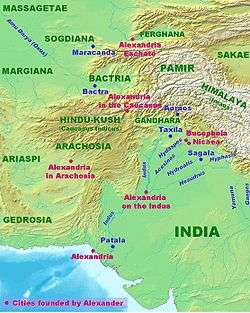Nicaea, Punjab

Nicaea or Nikaia (Ancient Greek: Νίκαια)[1] was a city in what is now the Punjab, one of the two cities founded by Alexander the Great on opposite sides of the Hydaspes river. The second city founded by Alexander on the Hydaspes was Bucephala.[2][3] It was at Nicaea or Bucephalia, which appears to have been on the opposite bank, that Alexander (according to Strabo)[4] built the fleet which Nearchus subsequently commanded, the country in the immediate neighbourhood having abundance of wood fit for ship-building.[5]
Following the Battle of the Hydaspes, Alexander founded two cities. One of the sites of the battle he named Alexandria Niceae meaning Victory. The site of that city is still undetermined.[6] Any attempt to find the ancient battle site is doomed, because the landscape has changed considerably.[6]
A number of candidates have been put forward for the location:
- For the moment, the most plausible location is just south of the city of Jhelum, where the ancient main road crossed the river, and where a Buddhist source indeed mentions a city that may be Nicaea.[6] Huntingford identifies this Alexandria with a large mound west of Jhelum city, while Lendering cites Jhelum in more general terms. The nineteenth-century British traveller Alexander Burnes, visiting the region in 1831, suggests the "extensive ruins called Oodeenuggur" 15 miles south of Jhelum are the remains of Nicaea, with a mound at Mong on the opposite bank of the Hydapses being the site of Bucephalia.[7]
- The identification of the battle site near modern Jalalpur/Haranpur is certainly erroneous, as the river, in the ancient times, meandered far from these cities.[6]
- The Hungarian archaeologist and Silk Road expert Sir Marc Aurel Stein believed that instead of using the road from Taxila to Jhelum which dates from medieval times, Alexander's army would have gone south to cross the river near modern Bhera. At this site the battle would have happened near the town of Mong. The topography, river orientation and natural features including salt cliffs in this vicinity match closely the description given in ancient sources. To further support this claim, the residents of Mong and nearby Phalia have a traditional claim that Mong is Hellenistic Nicaea.
See also
References
- ↑ Arrian 5.19; Curt. 9.3.23; Strabo. Geographica. xv. p. 698. Page numbers refer to those of Isaac Casaubon's edition.
- ↑ Alexander the Great: a reader Author Ian Worthington Editor Ian Worthington Edition illustrated, reprint Publisher Routledge, 2003 ISBN 0-415-29186-0, ISBN 978-0-415-29186-6 Length 332 pages p. 175
- ↑ Alexander the Great: his towns
- ↑ Strabo. Geographica. xv. p.698. Page numbers refer to those of Isaac Casaubon's edition.
- ↑

- 1 2 3 4 P.H.L. Eggermont, Alexander's campaign in Southern Punjab (1993).
- ↑ Burnes, Alexander (2012). Travels into Bokhara. London: Eland Publishing Limited. pp. 106–107. ISBN 978-1-906011-71-0.